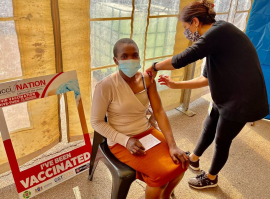
The South African COVID-19 Modelling Consortium (SACMC) says South Africa is likely to experience lower death and hospitalisation rates in the fourth wave due to vaccination coverage.
“Increases in cases will still lead to increases in admissions, but as demonstrated in the modelled scenarios, sizeable waves of cases may occur with a relatively low level of admissions,” the consortium said on Wednesday.
The SACMC is a group of researchers from academic, non-profit, and government institutions across South Africa, coordinated by the National Institute for Communicable Diseases (NICD), on behalf of the Department of Health.
Experts in the consortium, however, have raised the alarm on a new Variant of Concern (VOC), which may contribute to a substantial increase in transmission.
The experts have predicted that if a variant with a 25% relative reduction in protection from prior infection and vaccination hits South Africa, hospital admissions may be higher compared to the ‘no new variant’ scenarios.
Nevertheless, they believe the lifesaving vaccines will continue to have an impact and may protect the most vulnerable from severe illness, particularly the elderly.
“If increases in contacts occur in January, as opposed to November, later and smaller waves are expected as a larger proportion of the population will be vaccinated,” SACMC said.
In addition, the researchers said smaller peaks in admissions do not imply that future waves will have less impact on the health system and healthcare workers.
“Whether or not the admissions will result in overwhelmed hospitals and avoidable COVID-19 deaths also depends on how much hospital capacity can continue to be made available.”
Even with continued behavioural fatigue, the SACMC said the rapid vaccination of the population provides a powerful tool to reduce severe illness and death.
“Vaccination against COVID-19 reduces both a vaccinee’s risk of developing severe and critical COVID-19 and the risk of infection, though the latter effect wanes to lower levels within three months post-vaccination.”
The projections include the effect of the ongoing vaccine rollout, assuming an inoculation rate that achieves vaccine coverage of 70% of adults vaccinated with at least one dose of Johnson & Johnson or Pfizer by 31 March 2021.
The modellers have also emphasised behaviour change, as it pertains to the rate of potentially infectious contacts between people and continues to be one of the main drivers of the timing and peak of the fourth wave.
According to the modelling update, factors that influence contact rates include holiday travel, large events such as religious and political gatherings, changes in adherence to public health and social measures such as mask-wearing, and government-imposed restriction levels.
As of 17 November 2021, South Africa had recorded a total number of 2 926 914 laboratory-confirmed cases, while the official death toll sat at 89 515.
“Importantly, however, across provinces, the higher vaccination rates among the population aged 60 and above reduce projected severe cases and admissions in this population to low levels.
“On the other hand, admissions in the youngest age group (zero to 14 years) are projected to reach levels close to wave three.” – SAnews.gov.za


